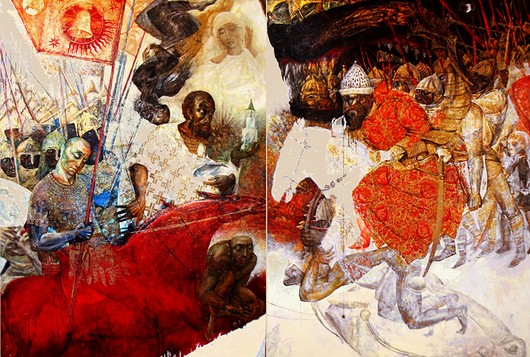“RUSSIAN ARMAGEDDON – THE SHELON RIVER BATTLE” 1990-1993, oil on canvas, golden foil, 195×290 cm.
Martha the Mayoress at the Destruction of the Novgorod Veche, by Klavdiy Lebedev
Ivan launches attack on Novgorod, wins victory at Shelon River on 14 July – When Aleksandr of Yaroslavl dies, Ivan annexes the principality.
In May, after making careful diplomatic preparations to isolate the city, Ivan III declared war on Novgorod. Novgorod had just signed a defense treaty with Casimir of Lithuania in February, 1471, but the Lithuanians did not come to the city’s aid. Novgorod’s hired commander then was Mikhail of Kiev. After a dispute in which Novgorod did not support Mikhail in his claim for Kiev, he left the city on 15 March 1471. Thus, Novgorod had to face the might of Grand Duke Ivan III alone. In June, three armies left Moscow; the first commanded by Princes Daniel D. Kholmsky and Fedor D. Starodubski-Pestry, and the second commanded by Prince Vasilii I. Obolenski-Striga included Tatar troops. Ivan commanded the third army himself and had with him his Tatar Tsarevich of Kasimov, Danyan. They left Moscow on 20 June. The Grand Duke secured the alliance of Pskov and Tver and Viatka as well. The Pskov army opened the war on 10 July with a series of skirmishes. Pskov also blocked the path of Casimir against his possible support of Novgorod.
Ivan went to Torzhok where he met the detachments of Tver and the armies of his brothers and cousins. The major battle occurred on 14 July at the River Shelon. The 40,000-man Novgorod army, largely composed of a civilian militia, was disorganized and uncoordinated. The 5,000 Muscovites routed the Novgorodians, killing 12,000. Details of the battle vary according to the different chronicles, but it seems that the Muscovites drew the Novgorodians into an ambush prepared by Danyan’s Tatars. Another battle took place in the north on 24 July, when Ivan sent a force under Boris Slepets down the Northern Dvina from Viatka. This 2,970-man unit then faced the 12,000 men under the Novgorod professional commander, Prince Vasilii V. Gorgaty-Shuyaki. This battle on the River Shilenga was a defeat for Novgorod. The peace treaty allowed Novgorod some local autonomy, but in reality it placed the city under the Grand Duke. He used lenient methods to absorb the city gradually and reduce his enemies while gaining time to observe political conditions in the city.
MARFA IVANOVNA BORETSKAYA
Charismatic leader of the Novgorodian resistance to Muscovite domination in the 1470s.
Marfa Boretskaya (“Marfa Posadnitsa”) was born into the politically prominent Loshinsky family, and married Isaac Andreyevich Boretsky, a wealthy boyar, who served as mayor (posadnik) of Novgorod from 1438 to 1439 and in 1453. She bore two sons, Dmitry and Fyodor. Marfa was widowed in the 1460s but remained one of the wealthiest individuals in Novgorod who owned slaves and sizable estates. Peasants on her lands to the north of Novgorod engaged in fishing, fur hunting, livestock raising, and salt boiling. Her southern estates produced edible grains and flax.
By the middle of the fifteenth century, the relations between the principalities of Moscow and Novgorod, long strained by chronic disputes over trade, taxes, and legal jurisdiction, intensified into overt hostilities. The campaign of 1471 was purportedly undertaken by Ivan III as a response to the efforts of a party of Novgorodian boyars to ally themselves with King Casimir of Lithuania. Marfa is accused in an anonymous essay, preserved in a single copy of the Sophia First Chronicle, of plotting to marry the Lithuanian nobleman Michael Olelkovich and rule Novgorod with him under the sovereignty of the Lithuanian king. The Cathedral of St. Sophia, seat of the archbishops and emblem of Novgorodian independence, would have thereby come under Catholic jurisdiction. No other sources corroborate these charges against Marfa, although her son Dmitry, who served as mayor during 1470 and 1471, fought against Moscow in the decisive Battle of Shelon (July 14, 1471) and was executed at the order of Ivan III on July 24, 1471. Her other son Fyodor has also been identified with the pro-Lithuanian faction in Novgorod. The evidence for his activity is ambiguous. Nevertheless, he was arrested in 1476 and exiled to Murom, where he died that same year. Following the final campaign of 1478, Ivan III ordered that Muscovite governors be introduced into Novgorod and that the landowning elite be evicted and resettled. On February 7, 1478, Marfa was arrested. Her property was confiscated, and she was exiled. The date of her death is not known.
